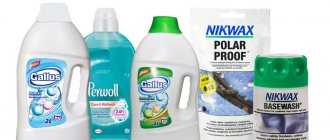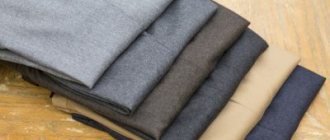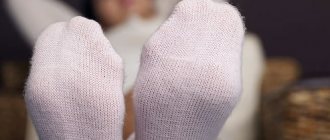A suit is an integral part of a business image and a stylish evening outfit. The complexity of the cut and the variety of sewing materials complicate the process of caring for a suit.
You can preserve the appearance, shape and color of your favorite item only if you follow the basic washing rules.
Read the article about whether and how to wash a suit (men's, women's, school) in an automatic washing machine and manually at home.
Is it possible?
The main information about whether the suit can be washed and in what way is indicated on the manufacturer's label.
If the tag is lost, you can navigate by the type of fabric:
- velvet, wool, corduroy and tweed are cleaned only using the dry method;
- wool mixture, satin can be washed by hand;
- Linen, cotton and synthetic fabrics can be washed in a washing machine.
Before washing, you need to weigh your options, and if you have even the slightest doubt about your own abilities, it is better to entrust the cleaning of your suit to dry cleaning professionals.
How to wash at home?
Once the method of cleaning the suit has been determined, it is necessary to study the features and sequence of all actions in order to avoid final damage to your favorite item.
Hands
Gentle hand washing in the shower will help maintain the original shape of the suit.
Algorithm of actions:
- The jacket and trousers are shaken out of dust, and the pockets are checked for small debris.
- The product is hung on hangers above the bathtub.
- Wet the cloth with warm water (no more than 40°C) from the shower.
- Using a soft brush dipped in a soapy solution (washing gel for delicate items is dissolved in water), carefully treat particularly dirty, worn-out areas.
- Rinse the product with running water from the shower.
- Without removing it from the hanger, the suit is hung out to dry in a dark, well-ventilated place.
In the typewriter
After carefully studying the manufacturer's label with care instructions and making sure that machine wash is allowed, you can safely get to work.
Algorithm of actions:
Set to delicate or hand wash mode, water temperature no more than 20-30C. The spin is turned off (this will help maintain the shape of the jacket).- Liquid detergent is poured into a special compartment.
- The jacket is placed in a special mesh bag and, together with the trousers, is loaded into the drum of the washing machine.
- After the washing is finished, the suit is immediately taken out. The jacket and trousers are hung out to dry on hangers. Moreover, the trousers must be carefully folded along the arrow.
Before washing, the suit must be checked for stains. Difficult, stubborn, old stains should be removed before the main wash.
Textile
Each material has its own characteristics. Stains are easier to remove from one surface than from another.
Silk
Natural silk belongs to the category of delicate materials that require especially careful handling. Such items should be washed exclusively by hand, using warm rather than hot water.
Some types of clothing may have a delicate setting, so in this case you can use the machine. As for drying, everything is usual here; such things need to be ironed using a rag, and the things should be slightly damp.
Viscose
Viscose can be called one of those materials that is processed by hand. These clothes need to be treated in the same way as silk items, but you can pre-soak them for half an hour. Dissolve the powder in water, wash with massaging movements so as not to deform the product. You cannot twist it; the material requires careful handling.
Cotton
Items that contain 100% cotton are machine washable, as modern technology has a corresponding program. The temperature in this mode can reach 95 degrees. You can pre-soak cotton clothes if there are heavy stains
Before washing, it is important to sort items by fabric type and color. It is not recommended to soak clothes with bright colors, otherwise they will fade
Velveteen
Corduroy products require special treatment, so you need to study the rules so as not to damage things or disrupt the structure of the fabric. The first thing to do is to rid your clothes of dust, which accumulates in the folds of the material during wear. It is much more difficult to remove this from a wet product, and sometimes it is not possible at all. Shake the item and use a sticky roller or brush to go over the entire surface.
Once you have gotten rid of the junk, move on to the next step. You cannot resort to machine washing, since at high speeds the structure will be damaged and cannot be restored. Therefore you will need to work manually. Prepare warm soapy water and place the item in it. Avoid bleaching powders and stain removers to protect the structure of the fabric.
Sintepon and holofiber
Sintepon and holofiber, which are among the most common fillings for blankets and winter jackets, do not require special cleaning. You should not wash blankets too often, as the products will quickly lose their shape and heat-protective function.
As a detergent, use liquid powders and gels that will not clog into pores, are easily washed out, and do not leave streaks. As for bleach, it is not used on synthetic fabrics and is only suitable for cotton items.
Linen
Linen items are classified as natural fabrics; machine washing is not suitable here. Do not use products that contain chlorine, avoid bleaching powders. For white things, gel is suitable.
Microfiber
Microfiber can be washed by hand or in a washing machine. Often these fabrics are used to make underwear and lightweight items. Each product must be coated with a paste made from water and soda. Then leave it for an hour, after which dissolve the liquid soap in warm water and place the item there. You can lightly wipe areas where there are stains or heavy dirt.
To rinse, use warm running water and then cold water (when you get rid of any soap residue). At the final stage, prepare a solution of water with lemon juice or acid and rinse the product again several times.
Spandex
For those who do not know how to wash spandex items, the following advice will be useful. You will need to use the delicate mode of the machine: this way you can deal with any dirt
It is important to pay attention to the temperature so that clothes made from such fabric do not lose their elasticity. Don't exceed 40 degrees and the results will be amazing. As soon as the wash is completed, turn on the appropriate spin cycle so as not to damage the integrity of the material
As soon as the wash is completed, turn on the appropriate spin cycle so as not to damage the integrity of the material.
Dry cleaning
Most often, the dry cleaning method is recommended for suits made from expensive woolen, corduroy, and velvet fabrics.
Dry cleaning is the treatment of fabric with a dry brush with soft bristles, as well as the use of special aerosols that absorb dirt without wetting the clothes.
Before you start cleaning, the pockets are turned inside out and cleared of small debris . After this, particularly contaminated areas are treated with a sponge soaked in ammonia.
Then the fabric is treated with a special spray for dry cleaning, and after waiting the required time (indicated by the manufacturer on the packaging) it is cleaned with a special brush. Read about what dry washing is and how it is carried out here.
Removing various stains
There are enough ways to quickly clean fabric from various contaminants:
Liquid dish detergent will help get rid of greasy stains. It is enough to treat the stain with a sponge soaked in detergent and leave it for six to ten hours. Then, depending on the type of fabric, the suit is washed by hand or loaded into the washing machine.- Table vinegar will help get rid of fruit stains on clothes. It is enough to hold the suit over the steam, and then treat the stain with a cotton pad moistened with a table bite (alternatively, you can use freshly squeezed lemon juice).
- Milk and soap will help get rid of traces of fresh berries. To do this, the stain is first treated with a cotton pad soaked in milk, and then wiped with a sponge soaked in a soap solution.
- Table salt will cleanse the fabric of traces of champagne or wine. The alcohol stain should be thoroughly sprinkled with salt and left to dry. Afterwards, carefully brush off the salt and wipe off the dirt with a sponge soaked in ammonia.
- Rubbing alcohol will remove grass stains. It is necessary to treat the stain with a cotton pad moistened with alcohol. Hydrogen peroxide can help remove grass stains from white fabric.
It is better to take a suit with paint stains, complex, stubborn stains to the dry cleaner. Mistakes made when cleaning yourself can completely ruin the item.
Review of suit washing products
Dirt, grease, and sweat stains can be removed at home using improvised means or specialized household chemicals.
Folk
- Soap solution. In a bowl of warm water, dilute liquid soap until thick foam is obtained. Apply the product to the dirty area using a clothes brush or sponge.
- Water and vinegar. Mix in equal proportions, apply the solution with a cotton pad to dirty and greasy areas. Ventilate to remove the acrid smell of vinegar.
- Potato. Cut raw peeled potatoes into pieces, rub the cut into contaminated areas, and leave for 15-20 minutes. Remove traces of starch with a damp, clean cloth.
- Ammonia. Dilute 1 tbsp in one liter of warm water. l. ammonia, wipe the stained areas.
- Glycerol. Mix 1 liter of warm water, 10 ml of glycerin and 60 ml of ammonia. Pour the mixture into a container with a spray bottle, spray the jacket, then brush and steam.
Special
| Cleaner | Action |
| SONAX Xtreme | Foam for cleaning any fabric, removes traces of coffee, fruit, stubborn dirt, oil and grease stains. The product is effective in combating unpleasant odors and is suitable for dry cleaning. |
| Sano Spot Remover | Product for dry cleaning of synthetics, wool, silk. Removes stains from grease and coffee. Easy to apply and remove with a brush, leaves no residue. |
| Udalix Ultra | Stain remover pencil. Removes stains from coffee, wine, blood, lipstick, ink. Suitable for all types of fabric. Does not change the color of the fabric, maintains the whiteness of non-colored items. |
| Hagerty. Dry Cleaner Kit | Set of 2 products:
|
| K2r | Aerosol for all types of fabric. Removes oil and grease stains without washing, leaves no residue, and does not require washing. |
How to dry?
The first rule of drying that you need to learn is that you shouldn’t rush anywhere.
The suit cannot be wrung out or twisted. It is necessary to wait until the water has drained and only then hang the suit on hangers or lay it out on a horizontal surface to dry.
Also,
in order to maintain the original shape of the product, you must remember the following rules:
- Dry the suit only in a dark, well-ventilated place (preferably in the fresh air). If drying takes place in the bathroom, the door to the room should remain slightly open.
- It is better to dry the jacket on hangers, and the trousers laid out on a table or drying rack.
- Do not allow it to dry out. Only a slightly damp suit can be ironed perfectly.
Do not speed up the drying process with a fan or heating appliances. A sudden change in temperature can cause deformation and shrinkage of the product.
The role of water temperature for shrinkage of different fabrics
High exposure temperatures, as well as changing hot water to cold water, are the most effective ways to shrink products. The practical application of each method must take into account the type of material.
Cotton
Natural white cotton can not only be processed in hot water, but also boiled.
If the fabric is colored, contains a printed pattern or decorative elements, such processing is unacceptable.
What you can do:
- increase the temperature indicated on the product tag by 15ºС;
- add 150-200 units to the usual spin rates.
Synthetics
Polyester, spandex and other synthetics will be difficult to reduce significantly using any washing techniques. You can try washing it on a normal cycle for synthetics and spinning it at medium speed.
Another method is long-term aging in cold water - it is this that contributes to the shrinkage of synthetics.
If a synthetic product does not shrink, you will have to either throw it away or send it to a workshop for alteration.
Silk
Natural silk should not be exposed to high temperatures: washing in hot water, drying with hot air, treating with hot steam. Silk requires careful handling, otherwise the item may be damaged.
Clothes are soaked in warm water for half an hour. After this, rinse, wring out and hang in a draft.
Jeans
Cotton jeans made from non-Lycra material can be made a little smaller by washing in hot water. It should be taken into account that the shade of the trousers will lighten.
For machine washing the following is installed:
- temperature from +60ºС to +90ºС;
- spin – to maximum;
- automatic drying possible.
This method is not suitable for processing stretch denim fabric, since the lycra included in its composition is not allowed to overheat.
Linen
When processed in hot water, linen clothing may shrink down one size. For these purposes, it is possible to use a washing machine or carry out manual processing.
Linen products often have embroidery. If things have this or that decor, then you should not reduce the size by exposure to hot water - the appearance will suffer.
Wool
Natural wool shrinks very well. Under the influence of hot temperature, a thing can shrink greatly - literally by 2 times. The water temperature for reducing clothing should be chosen approximately 15ºС higher than usual.
To achieve the effect, the product is soaked for a short time. After this, wash in cold water. When soaked for a long time, wool tends to stretch rather than shrink.
Knitwear
It is very easy to spoil a knitted item, so it is better to do it manually, very carefully:
- Pour water into the basin at a temperature slightly (10ºС) higher than indicated on the tag.
- Immerse the item for a quarter of an hour.
- Wring out the item through a towel.
- Dry horizontally on a towel.
How to stroke?
You can quickly iron a product only if you follow a certain sequence of actions:
Ironing begins with the jacket. Lay it out on the ironing board and, turning on the iron in steam mode, begin to carefully iron the back, sides, and lapels from the wrong side. From the outside, using a special attachment for the ironing board, iron the sleeves of the jacket and outer pockets. Iron the suit only through a damp cloth (preferably gauze).- Having ironed the jacket, you can start ironing the trousers. They are turned inside out, and through gauze, in the steaming mode, they begin to thoroughly iron the area of the pockets, waistband, and trouser legs. If it is necessary to iron the creases, the trousers are turned right side out, fold the trouser legs together and thoroughly iron the line of the creases.
- A well-ironed suit is hung on hangers.
Read about how to iron a jacket here. This article will tell you about ironing trousers.
This video will show you how to properly iron a suit:
Ironing
First you need to study the information on the label; usually it indicates the temperature at which the product is allowed to be ironed. Delicate fabrics, such as silk, require gentle treatment and low temperatures, while natural fabrics like linen and cotton will only smooth out at a high number of degrees.
- The product is ironed wet to reduce the percentage of shrinkage. During washing, the distance between the fibers of the fabric decreases, so when the housewife irons the jacket, she must artificially stretch the elbows a little with steam. This is easier to do when wet. If this is not done, the item will be stiff when worn and will have to be “broken in” after each wash.
- To prevent shiny spots from appearing on the fabric from the iron, ironing should be done through gauze or cotton cloth. This is especially true for dark jackets - such stains are very noticeable on them.
Going to dry cleaning
Dry cleaning can help refresh a suit that can only be dry cleaned, remove stubborn, stubborn stains, and correct mistakes when washing it yourself.
For those who wear a suit every day, it is necessary to take things to the dry cleaner at least once every three months .
In order to refresh, remove dust and the unpleasant smell of stale items, experts recommend dry cleaning a suit that is worn only on very significant dates once every six months.
The cost of dry cleaning services depends on the size and type of fabric of the product, and the degree of contamination. On average, dry cleaning a suit will cost 1,300 rubles.
The video will tell you why it’s better to dry-clean your suit instead of washing it at home:
Features of care
After washing and drying the suit, it must be treated with a special polyurethane-based impregnation. It will restore the water-repellent properties of the fabric.
You can purchase such a product in specialized stores that sell goods for tourism and sports. Popular formulations:
- Holmenkol Textile Proof. The price of the spray is 900 rubles.
- ANTILIQ Membrane. The cost of impregnation is 300 rubles.
- Nikwax TX Direct. A 300 ml spray costs about 750 rubles.
Before processing a suit, you need to think about the conditions under which it will be used. The fabric, impregnated with a water-repellent composition, does not allow air to pass through, so it will be hot in summer.
You can store the suit in the closet, along with other things. Ordinary hangers help avoid the formation of creases. To prevent dust from settling on the product, you can use a fabric cover.
The video will show you how to make the Gorka suit waterproof:
Adviсe
When washing a suit, you must adhere to the following recommendations:
- Do not use dry abrasive powders when washing. They are not completely rinsed out of the fabric, leaving streaks.
For black suits, you must use special detergents for dark fabrics.- Woolen and wool-blend items are washed using liquid detergent containing lanolin.
- It is prohibited to wash suits with products containing chlorine and ammonia.
- To make ironing a natural cotton suit easier, rinse it in water with added fabric softener.
- You should not put on your suit immediately after ironing. The product must be allowed to cool, otherwise it will immediately wrinkle.
You will find maximum useful information about washing clothes and various fabric products here.
What is the best way to wash?
There is a wide range of products on the market for cleaning different types of clothes. The powder washes well in the machine, it dissolves quickly and copes with various stains. It is recommended to use a liquid product during manual cleaning, as it is less harmful to the skin. After conducting a simple experiment, you can see that bulk products (unlike liquid ones) are not washed very well; often their remains can be found in clothes made from natural fabrics.
Laundry soap is often used to wash socks, as it is harsh and effectively removes unpleasant odors. There are many options for this product on the market, so you can find something that is suitable for children's clothes, underwear and other types of clothing. It is necessary to choose a detergent according to the fabric from which the product is made, so do not be lazy and study this indicator.











